Which New York hotel will have homes for sale once its US$1 billion refurb is done?
Ad
Experiences
Which New York hotel volition have homes for sale once its Usa$1 billion refurb is done?
Manhattan's storied Waldorf Astoria will complete its billion-dollar refurbishment this twelvemonth, with 375 hotel rooms and 375 residences. Just is this the right time to be launching a super-lux property?
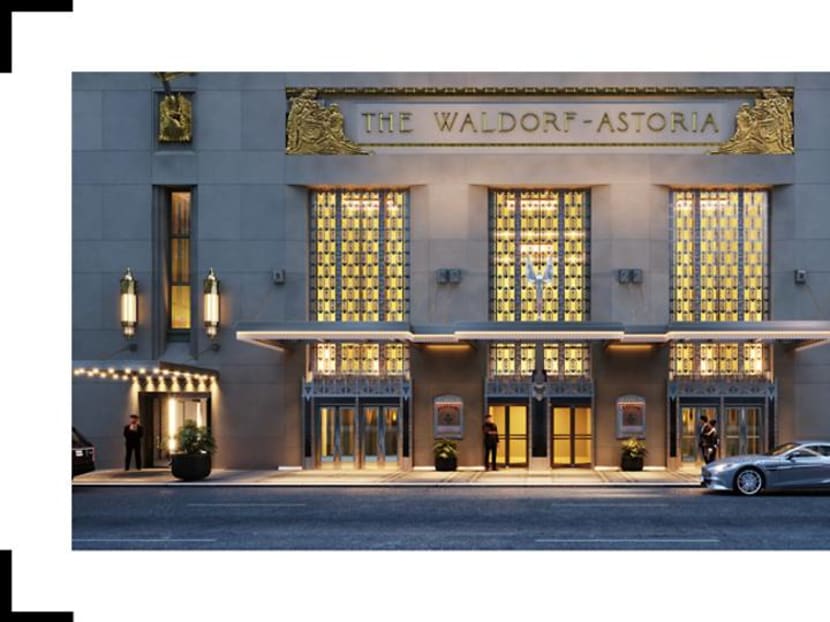
This year, the 47-storey Park Avenue building volition undergo a The states$i billion (Southward$1.37 billion) refurbishment. (Photograph: The Towers of the Waldorf Astoria)
The Waldorf Astoria was once the tallest, largest and grandest place to live in the world, but it is a building with a double identity and a foreign history.
It has two copper crowns; an Art Deco castle with twin towers. It is a dense mass of urbanity positioned above sparse air, situated non on the bedrock of Manhattan but in a higher place the tracks of the railway line that runs below.
It is a hotel, simply it has always offered apartments for rent, in which some of New York'southward most famous figures lived out their lives.
Information technology is a skyscraper but it is as well fatty to be a belfry. With 1,400 rooms, it is too large to be truly luxurious, and too familiar to be sectional. It is open to everyone but not, of course, to everyone.
READ> In this pandemic, people are buying U.s.$30 million condos in New York – sight unseen
"All the luxuries of individual home . . . " wrote the poet Langston Hughes on its opening in 1931. "Now, won't that be mannerly when the last flop-business firm has turned you down this winter?"
This year, the 47-storey Park Artery building is virtually to undergo another radical split, betwixt hotel and existent estate. As Hughes wrote: "Wouldn't a duplex high above the street be grand, with a view of the richest city in the world at your nose?"
When its US$1 billion (S$1.37 billion) refurbishment is complete, there will exist fewer but more spacious rooms: 375 residences, by and large in the towers and with their own entrance, and a further 375 hotel rooms. The Towers of the Waldorf Astoria volition embrace apartments ranging from studios (starting from Us$1.vii 1000000) to four-bedroom properties, penthouses to "marquee residences" with expansive terraces.
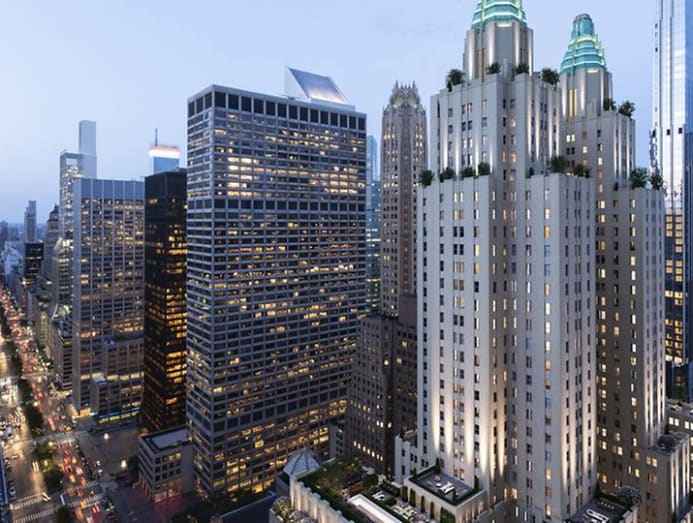
Sentry> Within a S$20 million penthouse in Singapore, with James Dyson as your neighbour
The branded residences are the commencement to have been available to purchase in the hotel. Information technology is an ambitious projection: US$2.vi billion worth of apartments will exist entering a post-pandemic New York property marketplace that was already under pressure.
Converting parts of the Waldorf Astoria into condos was a gamble before COVID-nineteen, as Manhattan is awash with unsold luxury apartments. According to i real estate consultant, there are more than than 8,500 unsold newly built units in Manhattan. At present it volition be even more of a challenge.
But, as befits the first hotel to offer room service, all residents volition have access to the services of the hotel ("at an ultra-luxury level"), mediated through "concierge closets", spaces between the staff corridors and apartments accessible to both staff and residents for the exchange of dry cleaning, parcels and empty champagne bottles. Now, they are existence marketed as the perfect tools for safe distancing and self-isolation.
Family FEUDS AND FRAUDSTERS
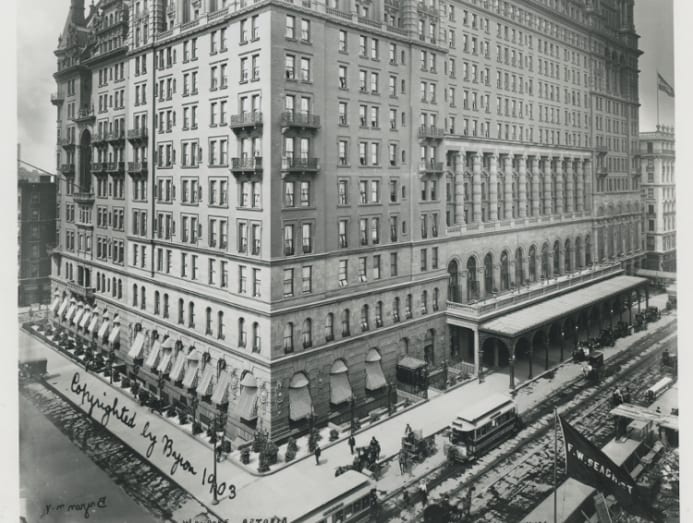
In 2022 the Waldorf Astoria was sold for nigh United states of america$2 billion to Anbang, the globally ambitious merely troubled Chinese insurance company, making it the most expensive hotel ever. In 2017, Anbang founder Wu Xiaohui was detained by the Chinese government as office of 11 Jinping'southward crackdown on corruption. He was convicted of fraud and embezzlement and is at present in a Chinese jail.
The insurer was rebranded as Dajia. Information technology is non surprising that Donald Trump was the first Usa president not to stay here (traditionally, the hotel has hosted visiting United states of america presidents from Hoover to Obama).
If the hotel's buying appears troubled, its genesis, too, is a fantastic story of family unit feuds, inherited wealth, branding, architecture, real estate and financial and cultural leverage.
Its history begins with a mansion on 33rd Street and Fifth Avenue. John Jacob Astor III'due south house became a nexus for New York lodge and on his decease in 1890, the site was passed to his son William Waldorf Astor (who later in England became a peer and bought Cliveden and Hever Castle) and William's cousin John Jacob ("Jack") Astor IV, who would die on the Titanic in 1912.
William began piece of work on building the xiii-storey Waldorf Hotel on his part of the site. Jack followed by building the 16-storey Astoria hard up confronting it on his part. The cousins' relationship was fraught, but they managed to co-operate in business. William persuaded Jack to sell his half of the site.
The twin hotels became a ballroom for the city. In his brilliant analysis of the nature of New York architecture, Delirious New York (1978), the architect Rem Koolhaas wrote: "Waldorf pulls society from its hiding places to what becomes in effect a jumbo collective salon for exhibiting and introducing new urban manners (such as women lonely – all the same clearly respectable – smoking in public)."
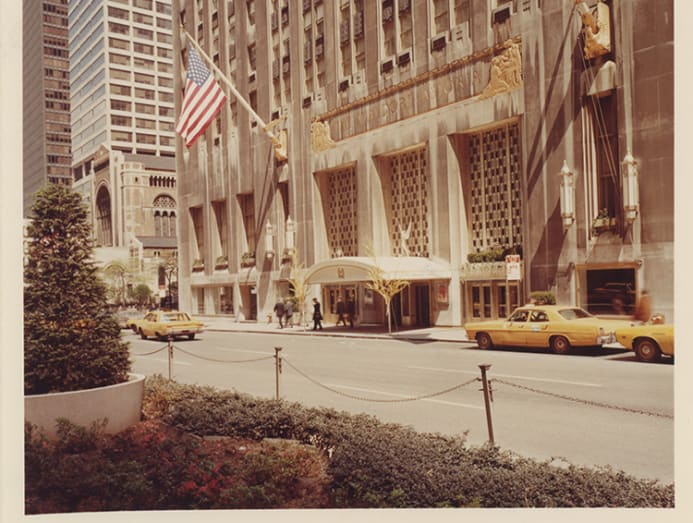
The schism betwixt the hotels was embodied in Peacock Alley, a glass-roofed arcade of shops that ran betwixt them (or so legend has it) and became Manhattan's poshest parade, a place where women could safely stroll and not get their skirts muddy.
Past the late 1920s, Manhattan's social middle had moved northward. The onetime hotels looked underscaled and dated and a new site was acquired further upwardly Park Avenue to catch wealthy passengers arriving at Chiliad Central Station. The old hotels were sold to developers in 1929 and became the site of the Empire State Building, just in time to miss the Wall Street crash.
The new hotel was to exist a monster, as large as the Empire Land simply squashed into a larger, fatter building, an entire block between 49th and 50th Streets. Designed past architects Schultze & Weaver, it opened in 1931 – a Manhattan mountain, its walls cliffs of granite and limestone, its interior a urban center in miniature.
A contemporary department through the building reveals its density and complexity, from the kitchens and bakery in the basement between the train lines to the elevated anteroom, the array of club rooms, ballrooms, restaurants, bars, radio studios, shops and suites; the Manhattan dream of the vertical urban center.
"It'due south a magnificent edifice," architect Robert AM Stern told me, "one of the all-time of the 1930s and often under-appreciated. The massing makes it appear like 2 buildings, everything is perfectly scaled to everything else and the details are beautiful. It represents a not bad moment in New York civilisation and compages."
Everything seems to take happened there, from the launch of the LP record in 1948 to IBM's personal figurer in 1981. Long-term residents who rented suites for astonishing sums included Cole Porter (whose piano is nonetheless in the hotel), mobster Bugsy Siegel, Marilyn Monroe and Frank Sinatra (he rented Porter'south old suite in 1964 for US$1 million a year).
Information technology became the New York base of operations of every U.s.a. president until the current hotelier incumbent. Just every bit that Langston Hughes poem, Advertizement for the Waldorf Astoria, published before long after the 1931 opening, suggests, information technology was non for everyone.
"Take luncheon there this afternoon, all yous jobless.
Why not? Dine with some of the men and women who got rich off of your labour,
Who clip coupons with clean white fingers because your hands dug coal, drilled stone, sewed garments, poured steel
To let other people draw dividends and live easy."
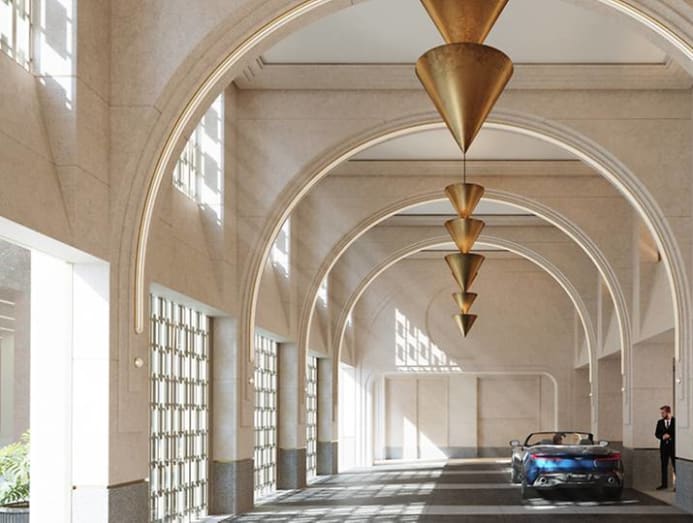
Lawrence Jackson, professor of English and history at Johns Hopkins, said: "Hughes introduces the complete panorama of black labour in the cosmos of opulence. Excavation the foundations, the grunt work. The hotel was a part of the exploitation of black labour."
Similar all such institutions at that time, the hotel was segregated, which has been deftly excised from its histories. Black people could work and perform there, but they could non stay as guests. Fifty-fifty in 1943 the hotel had to break its own policies to arrange the president of Liberia.
There are other subterranean histories. One is the semi-mythical Track 61, a leftover from the site's history as a power plant for 1000 Central. Right underneath the electric current hotel is a railway track with a platform, once used to transport coal and which was upgraded and occasionally used for access to the edifice, including surreptitiously by President Roosevelt in an attempt to conceal his inability. His entire armour-plated automobile would be loaded on to the train and taken up via a private elevator.
The track spur has made countless pop culture appearances, from a party thrown past Andy Warhol in 1965 to an escape route in the 2009 remake of The Taking of Pelham 123. The platform can only exist glimpsed from the windows of the Metro North trains leaving the station.
The hotel is a moving-picture show star in its own right, actualization first in Week-end at the Waldorf (1945), and later on in Coming to America, Smell of a Woman, Serendipity and dozens more.
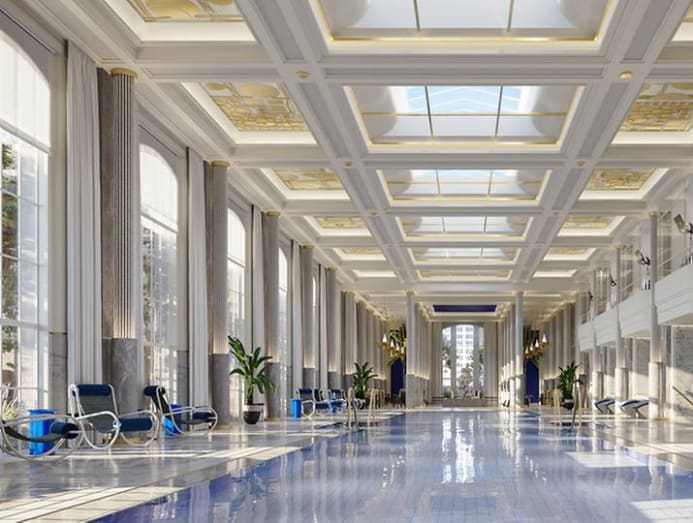

Interior designer Pierre-Yves Rochon will exist reinterpreting the Deco interiors (he redesigned London'southward smaller but similarly lavish Art Deco Savoy Hotel), while architects SOM take the chore of rejigging one of Manhattan's nigh complex buildings.
The Starlight Puddle, with the sky visible via a retractable roof, will comprise a winter garden, private dining room, library, workspaces and residents' own defended theatre.
I Waldorf regular over the years was Phyllis Lambert, builder, client for the nearby Seagram Edifice by Mies van der Rohe and founder of the Canadian Centre for Compages in Montreal.
"I loved the discretion and small lobby of the Waldorf Towers and its location near the Seagram Building and so I rented a pocket-sized suite every time I came to New York over 40 years," she told me.
"These suites were not my mode just of first-class quality which is incommunicable to find at present in NY. I knew the St Regis and the Plaza well but none compared to the intimacy, comfort and discretion. The staff hardly ever changed."

She added a note of caution almost its development. "I fearfulness that information technology [might] become ruined and glitzed every bit did the Ritz in Paris and London a few decades agone."
When I was shown effectually, a couple of months before lockdown began, in that location was non much to run across except a screening room, a slick video concentrating on the history and the restored "Spirit of Achievement", the slender Deco figure that adorned the hotel's canopy, sculpted by Icelandic creative person Nina Sæmundsson in 1931.
It felt a little underwhelming, a piddling too carefully under wraps. Is this the right time to be launching a super-lux holding in Midtown Manhattan? Certainly the cardinal section of the city is seeing a return of residential, as is Downtown, while the Upper Due east Side languishes a bit. And the brand is unassailable. The poet Wallace Stevens wrote: "You touch the hotel the way yous impact moonlight" in Arrival at the Waldorf.
It sounds romantic but, of course, you lot cannot touch moonlight. In fact, you can barely see anything. Boarded upwardly and forlorn, the building is a wearisome cliff of stained grayness limestone. Simply the idea of the Waldorf Astoria is indelible. It is a myth as much as it is a building and institution. And a myth makes priceless marketing.
By Edwin Heathcote © 2022 The Financial Times
Edwin Heathcote is the FT's compages critic
Sentry> Experiencing Waldorf Astoria in the Maldives, loving the fish in the wardrobe
Recent Searches
Trending Topics
Source: https://cnalifestyle.channelnewsasia.com/experiences/waldorf-astoria-new-york-247531

0 Response to "Which New York hotel will have homes for sale once its US$1 billion refurb is done?"
Post a Comment